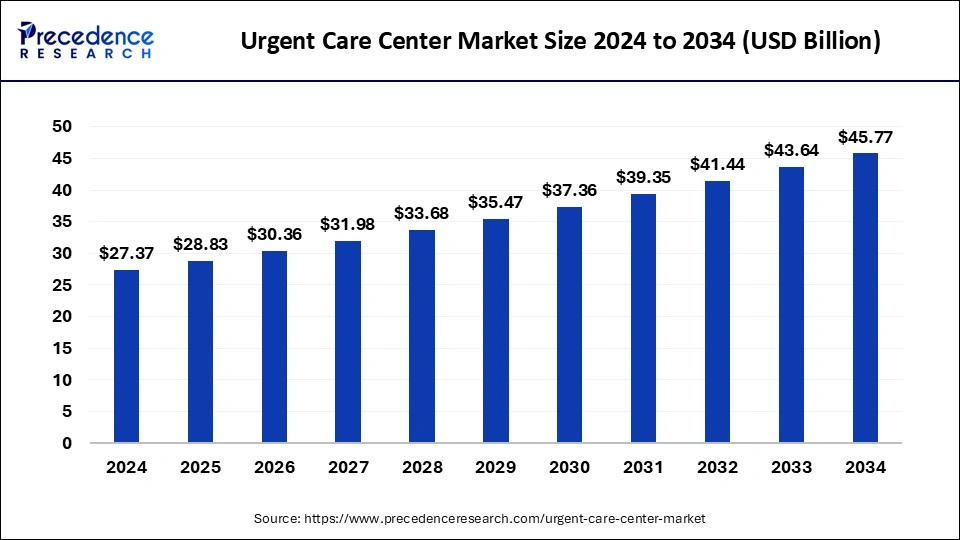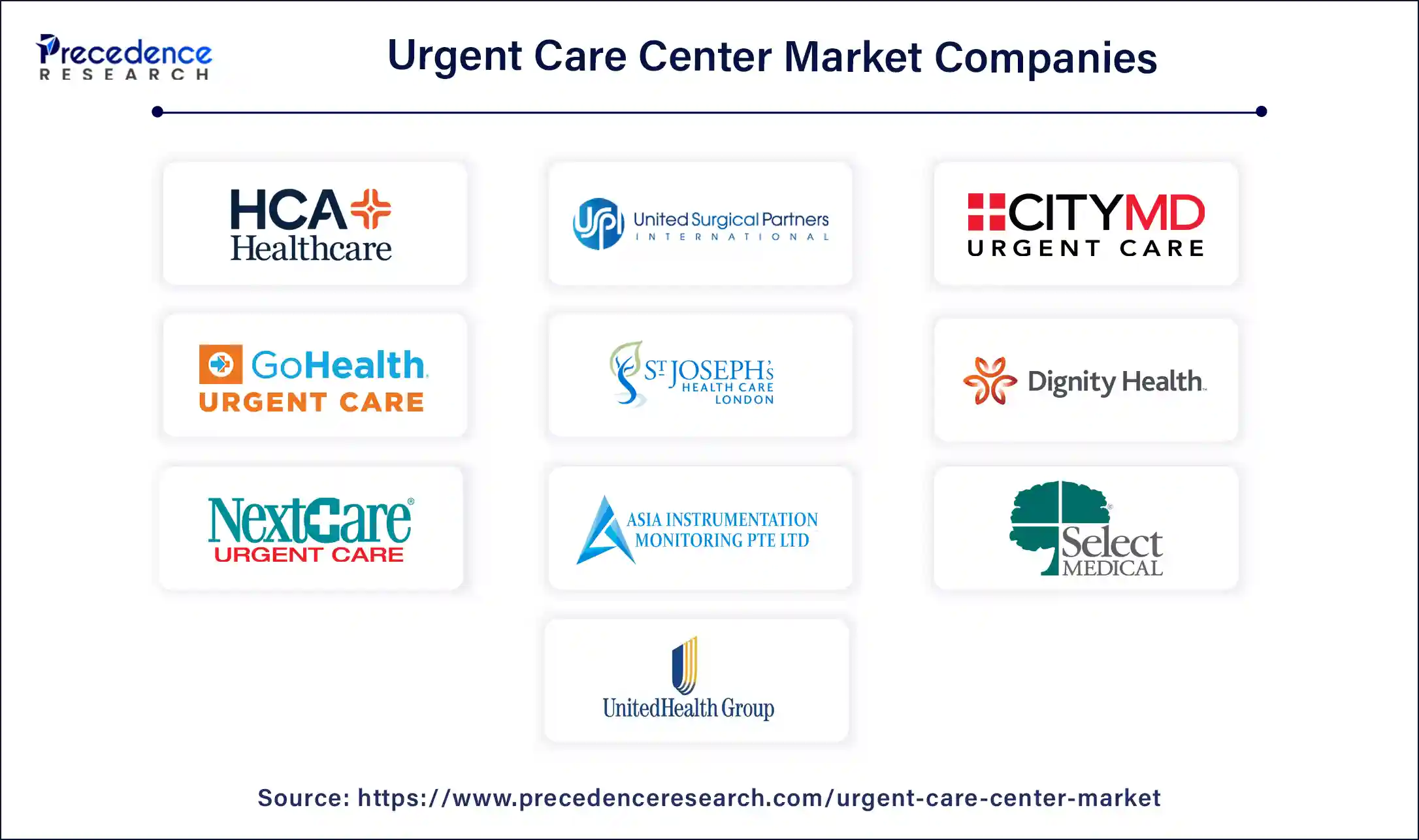January 2025
The global urgent care center market size is calculated at USD 28.83 billion in 2025 and is forecasted to reach around USD 45.77 billion by 2034, accelerating at a CAGR of 5.28% from 2025 to 2034. The market sizing and forecasts are revenue-based (USD Million/Billion), with 2024 as the base year.
The global urgent care center market size was estimated at USD 27.37 billion in 2024 and is predicted to increase from USD 28.83 billion in 2025 to approximately USD 45.77 billion by 2034, expanding at a CAGR of 5.28% from 2025 to 2034. The rise in improving healthcare infrastructure can boost the urgent care center market.

The urgent care center market refers to the medical institution that offers emergency care for injuries and diseases that are not life-threatening and is known as an urgent care center. The purpose of these facilities is to provide a compromise between emergency departments and general care physicians' offices. They usually accept walk-ins, so you may visit without making an appointment.
The urgent care center facilities are prepared to treat a wide variety of illnesses, including fevers, minor wounds like sprains and cuts, urinary tract infections, respiratory infections, and more. To aid with the prompt diagnosis and treatment of patients, they frequently have laboratory and X-ray machines on site. The longer hours that urgent care facilities offer often including evenings, weekends, and holidays when primary care clinics could be closed are one of its main advantages.
The urgent care center market is fragmented with multiple small-scale and large-scale players, such as St Joseph's Health Care London, NextCare Holdings, Inc., Select Medical Holdings, UnitedHealth Group, and HCA Healthcare.
| Report Coverage | Details |
| Market Size by 2034 | USD 45.77 Billion |
| Market Size in 2025 | USD 28.83 Billion |
| Growth Rate from 2025 to 2034 | CAGR of 5.28% |
| Largest Market | North America |
| Base Year | 2024 |
| Forecast Period | 2025 to 2034 |
| Segments Covered | Service, Ownership, and Regions |
| Regions Covered | North America, Europe, Asia-Pacific, Latin America, and Middle East & Africa |
Rising geriatric population
The rising geriatric population can boost the urgent care center market. People typically have more health problems as they become older and need to see a doctor more frequently. This covers acute and chronic diseases as well as age-related health issues. For these people, urgent care facilities can offer rapid and easy access to medical care.
Many elderly people may experience problems with their mobility or find it difficult to go to conventional healthcare facilities like hospitals or specialty clinics. Seniors who want urgent medical treatment but do not require emergency care may find urgent care facilities more convenient since they are conveniently placed in easily accessible places and have extended hours.
Superior urgent care for all ages patients
Superior urgent care for patients of all ages can grow the urgent care center market. The wider spectrum of patients can be drawn to urgent care facilities that provide top-notch care for individuals of all ages, from newborns to the elderly. These clinics are handy since families tend to favor healthcare facilities where all of their demands can be handled effectively. The convenience and accessibility of healthcare are highly valued by families that have elderly and/or youngsters in them. All-age urgent care facilities may offer a one-stop shop without the inconvenience of going to several doctors for minor ailments, accidents, immunizations, physicals, and other medical requirements.
Lack of skilled professional
The lack of skilled professionals slows down the urgent care center market. The lack of qualified workers may have a knock-on effect on the urgent care center industry, affecting things like service availability, quality of care, etc., and eventually slowing down the industry’s expansions.
Rising demand for telehealthcare
The rising demand for tele-healthcare can boost the urgent care center market. Patients in remote areas who might not have easy access to physical urgent care centers can now receive urgent care center services due to telehealth. By simply removing the need for travel and reducing wait times, telehealth enables patients to receive urgent care center service from the comfort of their homes, which may encourage more people to take advantage of urgent care center services, which can be the opportunity to grow the urgent care center market.
The acute illness treatment solutions segment dominated the urgent care center market in 2024. The purpose of urgent care is to treat medical conditions that need to be treated right away but are not serious enough to require an ER visit. This scope encompasses perfectly acute illnesses like infections, minor injuries, and sudden ailments. In comparison with traditional primary care offices, urgent care centers are more accessible because of their extended hours, which include evenings and weekends. Patients with acute illness who require immediate care but do not want to wait around for extended periods of time in emergency rooms are drawn to this convenience.
The trauma/injury services segment is expected to grow at a notable rate in the urgent care center market during the forecast period. Traumatic injuries are becoming more commonplace worldwide as a result of things like falls, traffic accidents, violent crimes, and natural disasters. Trauma care services must be improved and expanded in response to the rising number of injuries. The effectiveness and efficiency of trauma services are improved by technological innovations in medicine, which include better surgical methods, diagnostic tools, and trauma care equipment. The demand for these services is driven by the improved patient outcomes made possible by this advancement.
The hospital-owned segment dominated the urgent care center market in 2024 and is projected to sustain this dominance throughout the forecast period. The urgent care facilities owned by hospitals gain from being a part of bigger healthcare systems. Access to a variety of medical services and specialists, continuity of care, and easy patient referrals are all made possible by this integration. Because integrated care is so convenient, patients frequently choose these centers.
In general, hospitals have more financial resources than stand-alone urgent care facilities. Hospital-owned facilities can invest in cutting-edge technology, infrastructure, and medical equipment thanks to this financial support, which improves patient care and quality of life. The reputation for high-quality care and strong brand recognition are typical characteristics of established hospitals. In urgent care or complicated medical situations, patients are more likely to trust and select urgent care facilities affiliated with reputable hospitals.
North America dominated the urgent care center market in 2024. Accessible and convenient care is now given priority in the U.S. healthcare system, in particular. By providing a middle ground for non-life-threatening conditions that require prompt attention, urgent care centers bridge a vital gap between primary care physicians and emergency rooms. Urgent care facilities frequently take a range of insurance plans, such as Medicaid and Medicare, and provide patients who choose to pay cash with upfront costs. A wide range of patients are drawn in by this flexibility.
Accessible healthcare services are in high demand in urban and suburban areas due to high population density. These densely populated areas are served by urgent care facilities that are positioned strategically. The expansion of urgent care facilities is facilitated by higher average income levels in North America, which make it possible for more people to pay for their own medical bills.
Asia Pacific is expected to grow at the highest CAGR in the urgent care center market during the forecast period. The need for healthcare services is rising in the region due to its large and expanding population. The need for easily accessible healthcare facilities, such as urgent care centers, is increasing due to the rapid urbanization trend. In order to lessen the strain on traditional hospitals, many Asia Pacific nations are making significant investments in expanding their healthcare infrastructure, which includes opening urgent care facilities.
The population of nations like China and Japan is aging quickly, resulting in an increased demand for acute and chronic healthcare services. The need for urgent care services that can offer prompt intervention is being driven by the rising prevalence of chronic diseases like diabetes, hypertension, and cardiovascular diseases.

By Service
By Ownership
By Geography
For inquiries regarding discounts, bulk purchases, or customization requests, please contact us at sales@precedenceresearch.com
No cookie-cutter, only authentic analysis – take the 1st step to become a Precedence Research client
January 2025
January 2025
January 2024
September 2024